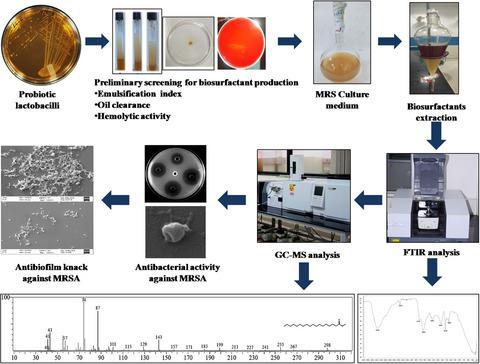当前位置:
X-MOL 学术
›
Lett. Appl. Microbiol.
›
论文详情
Our official English website, www.x-mol.net, welcomes your
feedback! (Note: you will need to create a separate account there.)
Functional group characterization of lactic bacterial biosurfactants and evaluation of antagonistic actions against clinical isolates of methicillin-resistant Staphylococcus aureus
Letters in Applied Microbiology ( IF 2.0 ) Pub Date : 2021-06-16 , DOI: 10.1111/lam.13523 B H Nataraj 1 , C Ramesh 1 , R H Mallappa 1
Letters in Applied Microbiology ( IF 2.0 ) Pub Date : 2021-06-16 , DOI: 10.1111/lam.13523 B H Nataraj 1 , C Ramesh 1 , R H Mallappa 1
Affiliation

|
The present study investigated the antimicrobial and antibiofilm potential of biosurfactants derived from Lactobacillus fermentum Lf1, L. fermentum LbS4 and Lactobacillus plantarum A5 against clinical isolates of methicillin-resistant Staphylococcus aureus (MRSA). The cell wall-bound and intracellular biosurfactants were extracted by solvent extraction method. Fourier-transform infrared spectroscopy-based characterization of biosurfactants revealed the heterogeneous chemical composition involving proteins, fatty acids and carbohydrate moieties in LbS4 and A5, while only the sugar and lipid fractions in Lf1. Fatty acid profiling using Gas chromatography-mass spectrometry indicated hexadecanoic acid and stearic acid as the predominant fatty acids in the biosurfactants of all these strains. Biosurfactants demonstrated dose-dependent antibacterial action against MRSA isolates with the highest inhibition zone diameter (30·0 ± 0·0 to 35·0 ± 0·0 mm) recorded at 400 mg ml−1. Biosurfactants showed an excellent staphylococcal antibiofilm activity by preventing the biofilm formation and disrupting the preformed biofilms. Visual inspection through scanning electron microscopy witnessed the biosurfactants-induced alteration in the cell membrane integrity and subsequent membrane pore formation on staphylococcal cells. Taken together, our findings emphasize the prospects of biomedical applications of biosurfactants as bactericidal and biofilm controlling agents to confront staphylococcal nosocomial infections.
中文翻译:

乳酸菌生物表面活性剂的官能团表征及对耐甲氧西林金黄色葡萄球菌临床分离株的拮抗作用评价
本研究调查了源自发酵乳杆菌 Lf1, L的生物表面活性剂的抗菌和抗生物膜潜力。发酵LbS4 和植物乳杆菌A5 对耐甲氧西林金黄色葡萄球菌的临床分离株 (MRSA)。细胞壁结合和细胞内生物表面活性剂采用溶剂提取法提取。基于傅里叶变换红外光谱的生物表面活性剂表征揭示了 LbS4 和 A5 中涉及蛋白质、脂肪酸和碳水化合物部分的异质化学组成,而 Lf1 中只有糖和脂质部分。使用气相色谱-质谱法进行的脂肪酸分析表明,十六烷酸和硬脂酸是所有这些菌株的生物表面活性剂中的主要脂肪酸。生物表面活性剂显示出对 MRSA 分离株的剂量依赖性抗菌作用,在 400 mg ml -1 时记录的最大抑菌圈直径(30·0 ± 0·0 至 35·0 ± 0·0 毫米). 生物表面活性剂通过防止生物膜形成和破坏预先形成的生物膜显示出优异的葡萄球菌抗生物膜活性。通过扫描电子显微镜目测观察到生物表面活性剂诱导的细胞膜完整性的改变以及随后葡萄球菌细胞上膜孔的形成。总之,我们的研究结果强调了生物表面活性剂作为杀菌剂和生物膜控制剂的生物医学应用前景,以应对葡萄球菌医院感染。
更新日期:2021-06-16
中文翻译:

乳酸菌生物表面活性剂的官能团表征及对耐甲氧西林金黄色葡萄球菌临床分离株的拮抗作用评价
本研究调查了源自发酵乳杆菌 Lf1, L的生物表面活性剂的抗菌和抗生物膜潜力。发酵LbS4 和植物乳杆菌A5 对耐甲氧西林金黄色葡萄球菌的临床分离株 (MRSA)。细胞壁结合和细胞内生物表面活性剂采用溶剂提取法提取。基于傅里叶变换红外光谱的生物表面活性剂表征揭示了 LbS4 和 A5 中涉及蛋白质、脂肪酸和碳水化合物部分的异质化学组成,而 Lf1 中只有糖和脂质部分。使用气相色谱-质谱法进行的脂肪酸分析表明,十六烷酸和硬脂酸是所有这些菌株的生物表面活性剂中的主要脂肪酸。生物表面活性剂显示出对 MRSA 分离株的剂量依赖性抗菌作用,在 400 mg ml -1 时记录的最大抑菌圈直径(30·0 ± 0·0 至 35·0 ± 0·0 毫米). 生物表面活性剂通过防止生物膜形成和破坏预先形成的生物膜显示出优异的葡萄球菌抗生物膜活性。通过扫描电子显微镜目测观察到生物表面活性剂诱导的细胞膜完整性的改变以及随后葡萄球菌细胞上膜孔的形成。总之,我们的研究结果强调了生物表面活性剂作为杀菌剂和生物膜控制剂的生物医学应用前景,以应对葡萄球菌医院感染。











































 京公网安备 11010802027423号
京公网安备 11010802027423号